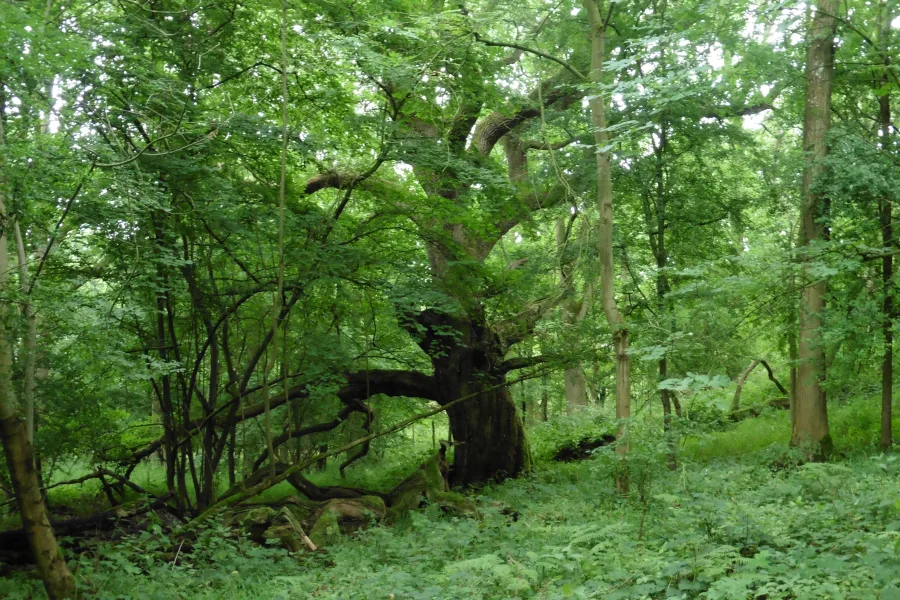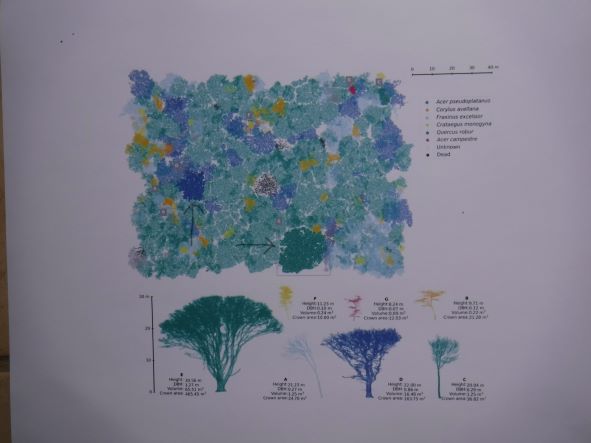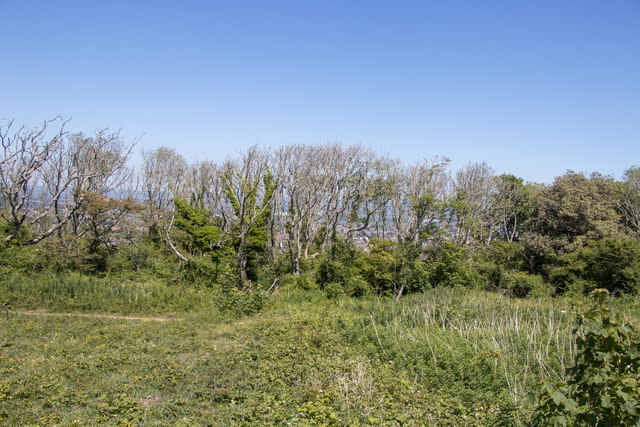
I campaign for protecting trees – especially trees growing to their natural capacity in the habitats in which they have evolved. I focus on the threat to these trees from non-native insects and various pathogens (fungi, nematodes …). I have often expressed my distress because others appear to place a low priority on this goal. I have also asked whether protecting trees might be given a higher priority by more decision-makers if they recognize trees’ vitally important role in countering climate change.
For this reason, I have blogged several times about studies examining the role trees play in sequestering carbon — see here & here & here.
A new study demonstrates that protecting large, old trees – almost by definition in their natural environment – is vitally important. Planting new, small, trees is helpful but cannot substitute for the venerable trees.
Calders and colleagues (full citation at the end of the blog; open access!) have used new technology to update assessments of the amount of carbon sequestered in trees. They conducted their study in a temperate hardwood forest – Wytham Woods, a typical broadleaf temperate forest in Oxfordshire, southern Great Britain. [Wytham Woods is also the site of two of the “Inspector Morse” mysteries – “Secret of Bay 5B” and “A Way Through the Woods”.]
They found that these trees sequester 1.77 times more carbon in their above-ground biomass (AGB) than previously believed based on currently-used models.
One consequence of their findings is that countries using the standard assessment method (which was developed by Robert Bunce in 1968) are reporting inaccurate carbon sequestration estimates to the United Nations per the Paris climate accords. (Calders et al. believe that calculations for conifer species are probably more accurate than those for deciduous forests.)
A second consequence is that death of large trees – from whatever cause – will result in greater loss of carbon storage than previously thought.
Old v. New Measurements
The underlying Bunce dataset and algorithm applied in most European biomass estimates were based on a small sample: 200 trees belonging to five taxa growing in one forest area. The models were derived by cutting down trees and weighing them to determine tree biomass. Smaller trees were used because they are easier to process. The scientists then extrapolated the biomass of bigger trees based on the assumption that correlation between tree size and mass is independent of tree size. This assumption has rarely been tested because of the difficulty and expense of carrying out this type of destructive sampling.
The higher estimates of carbon storage in Calders et al. arise in part from the bias towards small trees in calibration of the earlier models. Calders et al. found that trees do not follow a size-invariant scaling relationship, particularly at larger size; it is important to include crown area. Thus, Calders and colleagues calculated a higher sequestration rate for trees in Wytham Woods that fell within the size range used in developing the Bunce allometric model.
In addition, changes in forest management have increased the abundance of larger trees compared to the 1960s when Bunce carried out his study. Indeed, many of the trees in Wytham Woods are nearly twice as large as the trees used in the original calculation of biomass. The median dbh in Bunce (1968) is 8.4 cm; the mean dbh for the TLS dataset (based on a 2015 inventory) is 15.9 cm. The large trees represent a high proportion of the above-ground biomass: 50% of AGB in Wytham Woods was associated with fewer than 7% of the trees (those with dbh greater than 53.1 cm). All these trees were larger than the trees used to calibrate the widely used allometric model.
Calders et al. say that the distribution of tree size (trunk diameter) in Wytham Woods is representative of broadleaved species throughout Great Britain. Basal area had doubled in 40 years from 1974. Thus, the growth trajectory reflected at Wytham Woods – and presumably across Britain – resulted in a net carbon sink of ~1.77tha-1year-1ha in Calder et al’s 3D analysis. This is almost double the ~1tha-1year-1ha derived using the traditional allometric models. .
Methodology

Calder et al. used terrestrial laser scanning (TLS; terrestrial LiDAR) methods & 3-dimensional analysis to derive tree volume and convert this to above-ground biomass (AGB) and carbon sequestration. They scanned 815 live standing trees in Wytham Woods during winter so leaves did not complicate computations. They found:
- total volume of these 815 trees was 742.6±3.9m3ha-1.
- TLS-derived AGB = 409.9tha-1. This is significantly greater than the 231.9tha-1 resulting from applying the Bunce allometric models.
- In sum, 1.77 times more carbon is stored per ha according to this model than carbon values derived through the allometric AGB models developed by Bunce.
A Fly in the Ointment

Calder et al. describe the threat to European carbon sequestration projections caused by ash dieback. Ash dieback has been spreading across Europe since the 1990s – although the causal agent was not determined until 2006 (Paap et al.). It is killing European ash across the continent. Some of these trees are large – that is, store impressive amounts of carbon. In Wytham Woods specifically, ash dieback threatens some of the largest trees.
Ash dieback disease was first observed in the United Kingdom in 2012; it reached Wytham Woods in 2017. Ash contributed ~13.2% of the biomass carbon sequestration in the study area. However, the species’ presence in all of Wytham Woods might approach ~34%. Ash comprised 75% of seedlings in 2012. Ash is one of three species that contribute >26% of broadleaved tree AGB & carbon for Great Britain as a whole. The British Woodland Trust expects the UK to lose 80% of its ash trees. As a result, Wytham Woods, Britain, and, by extension, a significant amount of European temperate deciduous forests, are likely to become a substantial carbon source in the next decades.
I note that Europe has already lost any sequestration benefits it would have enjoyed from large elm trees due to “Dutch” elm disease. Various Phytophtoras are killing trees in Britain and Ireland.
I recently described threats to plane trees, pines, and other trees across Europe.
I interpret these findings as demonstrating that protecting large trees growing in natural ecosystems is highly important as we try to cope with climate change. This will require determined, sustained, and strategic actions in the face of disturbances predicted to increase as result of changes in climate and the human activities that contribute to climate change – e.g., overexploitation of natural resources, conversion of natural systems to human use, shipping goods around the globe, …
Calders and colleagues say we cannot afford to lose substantial reservoirs of carbon currently sequestered in temperate forests. Such forests currently account for ~14% of global forest carbon stocks in their biomass and soil. Their importance is growing because of widespread deforestation in the tropics.
What is To Be Done? (to cite Lenin)
Calders and colleagues call for several actions to address potential biases in biomass carbon estimates and drastically improve estimates of forest biomass:
(i) Research to improve knowledge about carbon sequestration levels in trees. This will require
a) greater sampling using such nondestructive methods as TLS to estimate AGB of a wider variety of forest types,
b) improved understanding of wood density, and
c) properly testing the fundamental assumption of size dependency in allometric models.
(ii) Develop empirical models of AGB that do not assume size invariance. This might require. This implies more destructive harvesting to obtain data from a variety of forest compositions, locations, etc,
(iii) Establish a biomass reference network of permanent sample plots specifically designed for estimating AGB. The improved data can then be fed into satellite-derived biomass estimates, which are likely to become the de facto standard for assessing the state and change of forest AGB at large scales. The GEO-TREES database can help. It aims to build on existing long-term ecological plot networks, by including TLS, airborne laser scanning & other ancillary data (including harvest measurements) to specifically allow for upscaling of AGB & development of new empirical models.
(iv) Ensure much better traceability in the use of allometric models. If applying a model to a site at several removes from the original data, e.g., published allometric models, clearly identify where and when the underpinning data were collected, the number and size range of trees from which models were derived, and clarify any assumptions regarding environmental conditions, wood density etc. Database initiatives such as GlobAllomeTree can help.
North American Situation
A study in 2019 (Fei et al. 2019; full citation at end of the blog) has already estimated that 41% of total live (woody) biomass in forests of the “lower 48” states is at risk from the most damaging of introduced pests. The greatest biomass loss was caused by emerald ash borer, Dutch elm disease, beech bark disease, and hemlock woolly adelgid. Before arrival of these non-native pests, mature ash, elms, beech and hemlock were large – providing significant storage of carbon (and other ecosystem services). A complication is that elms and beech, at least, began dying decades before the underlying (Forest Inventory and Analysis; FIA) data began to be collected. Consequently, the reported mortality rates underestimate the actual loss in biomass associated with these pests.
Did Fei et al. rely on biomass estimates based on measurements and algorithms now questioned by Calders et al.? One of the co-authors, Dr. Randall Morin, has told me that USFS scientists are shifting to new models that will result in a slight bump in overall biomass for the U.S. largely because of increased recognition of the biomass in crowns and limbs. However, the new models are based partly on a felled-tree study, so I wonder if they will have similar issues.
Certainly in some situations that threat posed by non-native pests is not yet being adequately incorporated. Badgley et al. (2022) analyzed the California cap-and-trade program to determine whether forest projects enrolled under its provisions can provide sufficiently permanent carbon sequestration. They determined that sequestration losses tied to mortality of one tree species (tanoak; Notholithocarpus densiflorus) due to one disease – sudden oak death – would fully deplete the “buffer pool” set aside to compensate for losses due to disease and insect infestations. This leaves the program unable to provide the promised benefits in carbon sequestration. SOD continues to spread and tanoaks (and other tree species) to die. California along is home to other tree-killing pathogens and insects, e.g., white pine blister rust, Port-Orford cedar root disease, Fusarium dieback, goldspotted oak borer …
Furthermore, the program allows enrollment of forests across the United States, so the multiple pests threatening ash, hemlocks, oaks, and other tree taxa across North America must also be accommodated. I have not even mentioned the likelihood that additional tree-killing pests will be introduced in the future.
How can scientists enhance the credibility of well-intentioned efforts to incorporate forest conservation into strategies aimed at mitigating climate change?
[A separate study by Oxford University has estimated that 2 billion tonnes of CO2 are removed from the atmosphere every year – 99% of it by trees. They point out that this is not sufficient to help Earth avoid temperatures rising above Paris-set levels. See an article by Lottie Limb, Reuters, published 19 January 2023 (sorry – I don’t have a direct link).]
SOURCES
Badgley, G., Chay, F., Chegwidden, O.S., Hamman, J.J., Freeman J. and Cullenward, D. 2022. Calif’s forest carbon offsets buffer pool is severely undercapitalized. Front. For. Glob. Change 5:930426. doi: 10.3389/ffgc.2022.930426
Bunce, R. G. H. (1968). Biomass and production of trees in a mixed deciduous woodland: I. Girth and height as parameters for the estimation of tree dry weight. Journal of Ecology, 56, 759–775.
Calders, K., H. Verbeeck, A. Burt, N. Origo, J. Nightingale, Y. Malhi, P. Wilkes, P. Raumonen, R.G.H. Bunce, M. Disney. Laser scanning reveals potential underestimation of biomass carbon in temperate forest. Ecol Solut Evid. 2022;3:e12197. wileyonlinelibrary.com/journal/eso3 open access!
Paap, T., M.J. Wingfield, T.I. Burgess, J.R.U. Wilson, D.M. Richardson, A. Santini. 2022. Invasion Frameworks: a Forest Pathogen Perspective. FOREST PATHOLOGY Current Forestry Reports https://doi.org/10.1007/s40725-021-00157-4
(UK) Woodland Trust https://www.woodlandtrust.org.uk/trees-woods-and-wildlife/tree-pests-and-diseases/key-tree-pests-and-diseases/ash-dieback/
Posted by Faith Campbell
We welcome comments that supplement or correct factual information, suggest new approaches, or promote thoughtful consideration. We post comments that disagree with us — but not those we judge to be not civil or inflammatory.
For a detailed discussion of the policies and practices that have allowed these pests to enter and spread – and that do not promote effective restoration strategies – review the Fading Forests report at http://treeimprovement.utk.edu/FadingForests.htm
or



